Delineation of Potential Groundwater Zones and Assessment of Their Vulnerability to Pollution from Cemeteries Using GIS and AHP Approaches Based on the DRASTIC Index and Specific DRASTIC
Abstract
1. Introduction
Design of Cemeteries in Portugal
2. Materials and Methods
2.1. Location of Cemeteries and the Study Area
2.2. Assessment of Groundwater Vulnerability
2.2.1. Mapping of GWPZs
2.2.2. Mapping of DRASTIC Index Vulnerability
2.2.3. Mapping of Specific DRASTIC Vulnerability
3. Results and Discussion
3.1. Development of Maps Depicting Site Characteristics
3.2. Development of the Thematic Maps and the DRASTIC-Based Vulnerability Map
3.3. Final Considerations
4. Conclusions
Author Contributions
Funding
Data Availability Statement
Acknowledgments
Conflicts of Interest
References
- Guttman, S.; Watson, J.; Miller, V. Till Death Do We Pollute, and Beyond: The Potential Pollution of Cemeteries and Crematoriums. Trent Univ. 2012. Available online: https://ia800209.us.archive.org/12/items/tilDeathDoWePolluteAndBeyondThePotentialPollutionOfCemeteriesAnd/TillDeathDoWePollute.pdf (accessed on 1 August 2023).
- Turajo, K.A.; Abubakar, B.S.U.I.; Dammo, M.N.; Sangodoyin, A.Y. Burial practice and its effect on groundwater pollution in Maiduguri, Nigeria. Environ. Sci. Pollut. Res. 2019, 26, 23372–23385. [Google Scholar] [CrossRef] [PubMed]
- Egbimhaulu, A.E.; Sophia, O.D.; Korede, A.S.; Adenike, O.E.; Adegboyega, A.O.; Omonigho, D.E.; Efeovbokhan, E.V. Contamination assessment of underground water around a cemetery: Case study of Ayobo cemetery in Lagos, Nigeria. Int. J. Eng. Technol. 2020, 13, 1283–1288. Available online: https://www.ripublication.com/irph/ijert20/ijertv13n6_28.pdf (accessed on 1 August 2023).
- Rugg, J. Defining the place of burial: What makes a cemetery a cemetery? Mortality 2020, 5, 259–275. [Google Scholar] [CrossRef]
- Dian, Z. Land for the Dead; Locating Urban Cemeteries. A Case Study of Guilin, China. Master’s Thesis, International Institute for Geo-Information Science and Earth Observation, Enschede, The Netherlands, 2004; pp. 1–86. Available online: http://www.itc.nl/library/papers_2004/msc/upla/zhang_dian.pdf (accessed on 1 August 2023).
- Larkin, M.T. An Analysis of Land Use Planning Policies for Cemeteries in Ontario. Doctoral Dissertation, Digital Commons Ryerson University, Toronto, Canada, 2011. Available online: https://digital.library.ryerson.ca/islandora/object/RULA%3A2200 (accessed on 1 August 2023).
- Nguyen, T.; Nguyen, L. Groundwater pollution by longstanding cemetery and solutions for urban cemetery planning in Ho Chi Minh City—From reality to solutions. MATEC Web Conf. 2018, 193, 02008. [Google Scholar] [CrossRef][Green Version]
- Zychowski, J.; Bryndal, T. Impact of cemeteries on groundwater contamination by bacteria and viruses–A review. J. Water Health 2015, 13, 285–301. [Google Scholar] [CrossRef] [PubMed]
- Canning, L.; Szmigin, I. Death and disposal: The universal, environmental dilemma. J. Mark. Manag. 2010, 26, 1129–1142. [Google Scholar] [CrossRef]
- Neckel, A.; Costa, C.; Mario, D.; Sabadin, C.; Bodah, E. Environmental damage and public health threat caused by cemeteries: A proposal of ideal cemeteries for the growing urban sprawl. Urbe 2017, 9, 216–230. [Google Scholar] [CrossRef]
- Kandoli, S.J.; Alidadi, H.; Najafpoor, A.A.; Mehrabpour, M.; Hosseinzadeh, A.; Momeni, F. Assessment of cemetery effects on groundwater quality using GIS. Desalination Water Treat. 2019, 168, 235–242. [Google Scholar] [CrossRef]
- Trindade, F.R.; Neckel, A. Meio Ambiente e Cemitérios, 2nd ed.; Goellner: Passo Fundo, Brazil, 2014; Volume 1. (In Portuguese) [Google Scholar]
- Vaezihir, A.; Mohammadi, S. Groundwater contamination sourced from the main cemetery of Tabriz. Iran. Environ. Forensics 2016, 17, 172–182. [Google Scholar] [CrossRef]
- Jonker, C.; Olivier, J. Mineral contamination from cemetery soils: Case study of Zandfontein Cemetery, South Africa. Int. J. Environ. Res. Public Health 2012, 9, 511–520. [Google Scholar] [CrossRef]
- Idehen, O.; Ezenwa, I.M. Influence of third cemetery location on the quality of domestic and groundwater resources in Benin City, Nigeria. J. Appl. Sci. Environ. Manag. 2019, 23, 5–11. [Google Scholar] [CrossRef]
- Turner, B.; Haygarth, P. Phosphorus forms and concentrations in leachate under four grassland soil types. Soil Sci. Soc. Am. J. 2000, 64, 1090–1099. [Google Scholar] [CrossRef]
- Engelbrecht, J.F.P. Groundwater pollution from cemeteries. In Proceedings of the WISA Biennial Conference and Exhibition, Cape Town, Southern Africa, 29–30 March 1998. [Google Scholar]
- Wang, J.; Rao, C.Y.; Lu, L.; Zhang, S.L.; Muddassir, M.; Liu, J.Q. Efficient photocatalytic degradation of methyl violet using two new 3D MOFs directed by different carboxylate spacers. CrystEngComm 2021, 23, 741–747. [Google Scholar] [CrossRef]
- Pan, Y.; Rao, C.; Tan, X.; Ling, Y.; Singh, A.; Kumar, A.; Li, B.; Liu, J. Cobalt-seamed C-methylpyrogallol[4]arene nanocapsules-derived magnetic carbon cubes as advanced adsorbent toward drug contaminant removal. Chem. Eng. J. 2022, 433, 133857. [Google Scholar] [CrossRef]
- Zychowski, J. The impact of cemeteries in Krakow on the natural environment–selected aspects. Geogr. Pol. 2011, 84, 13–32. Available online: https://rcin.org.pl/igipz/publication/17987 (accessed on 3 August 2023). [CrossRef]
- Geleta, S.B.; Briand, C.H.; Folkoff, M.E.; Zaprowski, B.J. Cemeteries as Indicators of Post-Settlement Anthropogenic Soil Degradation on the Atlantic Coastal Plain. Hum. Ecol. 2014, 42, 625–635. [Google Scholar] [CrossRef]
- Całkosiński, I.; Płoneczka-Janeczko, K.; Ostapska, M.; Dudek, K.; Gamian, A.; Rypuła, K. Microbiological analysis of necrosols collected from urban cemeteries in Poland. BioMed Res. Int. 2015, 2015, 169573. [Google Scholar] [CrossRef]
- Killgrove, K.; Montgomery, J. All roads lead to rome: Exploring human migration to the eternal city through biochemistry of skeletons from two imperial-era cemeteries (1st-3rd c AD). PLoS ONE 2016, 11, e0147585. [Google Scholar] [CrossRef]
- Morillas, H.; Marcaida, I.; Maguregui, M.; Upasen, S.; Gallego-Cartagena, E.; Madariaga, J.M. Identification of metals and metalloids as hazardous elements in PM2.5 and PM10 collected in a coastal environment affected by diffuse contamination. J. Clean. Prod. 2019, 226, 369–378. [Google Scholar] [CrossRef]
- Silva, L.F.; Oliveira, M.L.; Neckel, A.; Maculan, L.S.; Milanes, C.B.; Bodah, B.W.; Cambrussi, L.P.; Dotto, G.L. Effects of atmospheric pollutants on human health and deterioration of medieval historical architecture (North Africa, Tunisia). Urban Climb 2022, 41, 101046. [Google Scholar] [CrossRef]
- Toscan, P.C.; Neckel, A.; Maculan, L.S.; Korcelski, C.; Oliveira, M.L.S.; Bodah, E.T.; Bodah, B.W.; Kujawa, H.A.; Gonçalves, A.C. Use of geospatial tools to predict the risk of contamination by SARS-CoV-2 in urban cemeteries. Geosci. Front. 2022, 13, 101310. [Google Scholar] [CrossRef] [PubMed]
- Neckel, A.; Toscan, P.C.; Kujawa, H.A.; Bodah, B.W.; Korcelski, C.; Maculan, L.S.; de Almeida Silva, C.C.O.; Junior, A.C.G.; Snak, A.; Moro, L.D.; et al. Hazardous elements in urban cemeteries and possible architectural design solutions for a more sustainable environment. Environ. Sci. Pollut. Res. Int. 2023, 30, 50675–50689. [Google Scholar] [CrossRef] [PubMed]
- Dent, B.B.; Knight, M.J. Cemeteries: A special kind of landfill. In Proceedings of the IAH Sustainable Solutions Conference, Melbourne, Australia, 8–13 February 1998; International Association of Hydrologists: Kenilworth, UK, 1998. [Google Scholar]
- Rodrigues, L.; Pacheco, A. Groundwater contamination from cemeteries cases of study. In Proceedings of the International Symposium: Environment 2010: Situation and Perspectives for the European Union, Porto, Portugal, 6–10 May 2003; Volume 6, pp. 1–6. [Google Scholar]
- Hirata, R.; Suhogusoff, A.V. A proteção dos recursos hídricos subterrâneos no Estado de São Paulo [The protection of groundwater resources in São Paulo]. In Proceedings of the XIII Congresso Brasileiro de Águas Subterrâneas [XIII Brazilian Congress on Groundwater], ABAS, Cuiabá, Brazil, 19–22 October 2004; pp. 1–15. (In Portuguese). [Google Scholar]
- Neckel, A.; Korcelski, C.; Silva, L.F.O.; Kujawa, H.A.; Bodah, B.W.; Figueiredo, A.M.R.; Maculan, L.S.; Gonçalves, A.C.; Bodah, E.T.; Moro, L.D. Metals in the soil of urban cemeteries in Carazinho (South Brazil) in view of the increase in deaths from COVID-19: Projects for cemeteries to mitigate environmental impacts. Environ. Dev. Sustain. 2021, 24, 10728–10751. [Google Scholar] [CrossRef]
- Scalenghe, R.; Pantani, O.L. Connecting existing cemeteries saving good soils (for livings). Sustainability 2020, 12, 93. [Google Scholar] [CrossRef]
- Lins, E.; Lins, M.; Baltar, S.; Lins, M.; Maria, C.; Silva, M. Negative environmental impacts generated by cemetery: Case study. Int. J. Adv. Sci. Res. 2019, 4, 16–19. [Google Scholar]
- Zume, J.T. Assessing the potential risks of burial practices on groundwater quality in rural north-central Nigeria. J Water Health 2011, 9, 609–616. [Google Scholar] [CrossRef]
- NGCC. Potential of Cemetery Developments Assessing the Groundwater Pollution; National Groundwater and Contaminated Land Center: Bristol, UK, 2002; 13p.
- Sale, T.; Parker, B.; Newell, C.; Devlin, J. Management of Contaminants Stored in Low Permeability Zones—A State-of-the-Science Review. SERDP Project ER-1740. Strategic Environmental Research and Development Program. 2013. 348p. Available online: https://archive.org/details/DTIC_ADA619819 (accessed on 16 August 2023).
- Fiedler, S.; Dame, T.; Graw, M. Do cemeteries emit drugs? A case study from southern Germany. Environ. Sci. Pollut. Res. 2018, 25, 5393–5400. [Google Scholar] [CrossRef]
- Paiqa, P.; Delerue-Matos, C. Determination of pharmaceuticals in groundwater collected in five cemeteries’ areas (Portugal). Sci. Total Environ. 2016, 569, 16–22. [Google Scholar] [CrossRef]
- Albinet, M.; Margat, J. Cartographie de la Vulnérabilité à la Pollution des Nappes D’eau Souterraine; Bureau de Recherches Géologiques et Minières: Paris, France, 1970; Volume 2, pp. 13–22. (In French)
- Aller, L.; Lehr, J.H.; Petty, R. DRASTIC: A Standardized System to Evaluate Groundwater Pollution Potential Using Hydrogeologic Settings; National Water Well Association: Westerville, OH, USA, 1987. [Google Scholar]
- Vrba, J.; Zaporozec, A. Guidebook on mapping groundwater vulnerability. In IAH International Contributions to Hydrogeology; FRG, Heise Verlag: Hannover, Germany, 1994; p. 16. [Google Scholar]
- Gogu, R.C.; Dassargues, A. Current trends and future challenges in groundwater vulnerability assessment using overlay and index methods. Environ. Geol. 2000, 39, 549–559. [Google Scholar] [CrossRef]
- Machiwal, D.; Jha, M.; Singh, V.; Mohan, C. Assessment and mapping of groundwater vulnerability to pollution: Current status and challenges. Earth Sci. Rev. 2018, 185, 901–927. [Google Scholar] [CrossRef]
- Wachniew, P.; Zurek, A.J.; Stumpp, C.; Gemitzi, A.; Gargini, A.; Filippini, M.; Rozanski, K.; Meeks, J.; Kvaerner, J.; Witczak, S. Toward operational methods for the assessment of intrinsic groundwater vulnerability: A review. Crit. Rev. Environ. Sci. Technol. 2016, 46, 827–884. [Google Scholar] [CrossRef]
- Shirazi, S.; Imran, H.; Shatirah, A. GIS-Based DRASTIC method for groundwater vulnerability assessment: A review. J. Risk Res. 2012, 15, 991–1011. [Google Scholar] [CrossRef]
- Taghavi, N.; Niven, R.; Paull, D.; Kramer, M. Groundwater vulnerability assessment: A review including new statistical and hybrid methods. Sci. Total Environ. 2022, 822, 153486. [Google Scholar] [CrossRef]
- Simunek, J.; Sejna, M.; Van Genuchten, M. The HYDRUS-2D Software Package. 1999. Available online: https://www.pc-progress.com/Downloads/Pgm_Hydrus2D/HYDRUS2D.PDF (accessed on 17 August 2023).
- Rodriguez-Galiano, V.; Mendes, M.P.; Garcia-Soldado, M.; Chica-Olmo, M.; Ribeiro, L. Predictive modeling of groundwater nitrate pollution using random forest and multisource variables related to intrinsic and specific vulnerability: A case study in an agricultural setting (Southern Spain). Sci. Total Environ. 2014, 477, 189–206. [Google Scholar] [CrossRef] [PubMed]
- Asadi, P.; Hosseini, S.; Ataie-Ashtiani, B.; Simmons, C. Fuzzy vulnerability mapping of urban groundwater systems to nitrate contamination. Environ. Model Softw. 2017, 96, 146–157. [Google Scholar] [CrossRef]
- Bordbar, M.; Neshat, A.; Javadi, S. A new hybrid framework for optimization and modification of groundwater vulnerability in coastal aquifer. Environ. Sci. Pollut. Res. 2019, 26, 21808–21827. [Google Scholar] [CrossRef] [PubMed]
- Antonakos, A.; Lambrakis, N. Development and testing of three hybrid methods for the assessment of aquifer vulnerability to nitrates, based on the DRASTIC model, an example from NE Korinthia, Greece. J. Hydrol. 2007, 333, 288–304. [Google Scholar] [CrossRef]
- Pavlis, M.; Cummins, E. Assessing the vulnerability of groundwater to pollution in Ireland based on the COST-620 Pan-European approach. J. Environ. Manag. 2014, 133, 162–173. [Google Scholar] [CrossRef]
- Sorichetta, A.; Ballabio, C.; Masetti, M.; Robinson, G.; Sterlacchini, S. A comparison of data-driven groundwater vulnerability assessment methods. Groundwater 2013, 51, 866–879. [Google Scholar] [CrossRef]
- Ivan, V.; Madl-Szonyi, J. State of the art of karst vulnerability assessment: Overview, evaluation and outlook. Environ. Earth Sci. 2017, 76, 25. [Google Scholar] [CrossRef]
- Aslam, R.; Shrestha, S.; Pandey, V. Groundwater vulnerability to climate change: A review of the assessment methodology. Sci. Total Environ. 2018, 612, 853–875. [Google Scholar] [CrossRef]
- Fisher, G.J. The selection of cemetery sites in South Africa. In Proceedings of the 4th Terrain Evaluation and Data Storage Symposium, Midrand, South Africa, 3–5 August 1994. [Google Scholar]
- Hamza, S.; Ahsan, A.; Imteaz, M.; Rahman, A.; Mohammad, T.; Ghazali, A. Accomplishment and subjectivity of GIS-based DRASTIC groundwater vulnerability assessment method: A review. Environ. Earth Sci. 2015, 73, 3063–3076. [Google Scholar] [CrossRef]
- Sahoo, S.; Dhar, A.; Kar, A.; Chakraborty, D. Index-based groundwater vulnerability mapping using quantitative parameters. Environ. Earth Sci. 2016, 75, 522. [Google Scholar] [CrossRef]
- Barzegar, R.; Moghaddam, A.; Norallahi, S.; Inam, A.; Adamowski, J.; Alizadeh, M.; Nassar, J. Modification of the DRASTIC framework for mapping groundwater vulnerability zones. Groundwater 2020, 58, 441–452. [Google Scholar] [CrossRef]
- Hu, X.; Ma, C.; Qi, H.; Guo, X. Groundwater vulnerability assessment using the GALDIT model and the improved DRASTIC model: A case in Weibei Plain, China. Environ. Sci. Pollut. Res. 2018, 25, 32524–32539. [Google Scholar] [CrossRef] [PubMed]
- Stempvoort, D.; Ewert, L.; Wassenaar, L. Aquifer vulnerability index: A gis–compatible method for groundwater vulnerability mapping. Can. Water Resour. J. 1993, 18, 25–37. [Google Scholar] [CrossRef]
- Sheppard-Simms, E.A. Designing the Integral Cemetery. A Landscape Response to Sydney’s Burial Crisis. Master Thesis, University of New South Wales, Sydney, Australia, 2012. Available online: http://unsworks.unsw.edu.au/fapi/datastream/unsworks:10579/SOURCE01?view=true (accessed on 19 August 2023).
- Black, H.; Dubyna, J.; Rapke, M. Policy Approaches to Planning for Cemeteries in Halton Region. Prepared for Halton Region Planning Services Department. 2016. Available online: http://www.waynecaldwell.ca/Students/Projects/Halton%20Region%20Cemetery_Planning_April16.pdf (accessed on 19 August 2023).
- Rocque, D. Guidelines for the Selection and Development of Green Cemeteries in Maine. 2017. Available online: https://static1.squarespace.com/static/52f117dae4b0c08037396a20/t/5b92be37758d4635bdea764e/1536343611131/Green+Cemetery+Guidelines+%282%29.pdf (accessed on 19 August 2023).
- Reza, M.A. Spatial Planning of Muslim Cemeteries: A Focus on Sustainable Design Practice. In Proceedings of the 4th International Conference on Rebuilding Place, Penang, Malaysia, 6–7 November 2019; Volume 2, pp. 144–159. [Google Scholar] [CrossRef]
- Teixeira, J.; Chaminé, H.; Carvalho, J.; Perez-Alberti, A.; Rocha, F. Hydrogeomorphological mapping as a tool in groundwater exploration. J. Maps 2013, 9, 263–273. [Google Scholar] [CrossRef]
- Teixeira, J.; Chaminé, H.; Espinha Marques, J.; Carvalho, J.; Pereira, A.; Carvalho, M.; Fonseca, P.; Perez-Alberti, A.; Rocha, F. A comprehensive analysis of groundwater resources using GIS and multicriteria tools (Caldas da Cavaca, Central Portugal): Environmental issues. Environ. Earth Sci. 2015, 73, 2699–2715. [Google Scholar] [CrossRef]
- Gonçalves, V.; Albuquerque, A.; Carvalho, P.; Almeida, P.; Cavaleiro, V. Groundwater Vulnerability Assessment to Cemeteries Pollution through GIS-Based DRASTIC Index. Water 2023, 15, 812. [Google Scholar] [CrossRef]
- Salem, Z.; Sefelnasr, A.; Hasan, S. Assessment of groundwater vulnerability for pollution using DRASTIC Index, young alluvial plain, Western Nile Delta, Egypt. Arab. J. Geosci. 2019, 12, 727. [Google Scholar] [CrossRef]
- Wang, J.; He, J.; Chen, H. Assessment of groundwater contamination risk using hazard quantification, a modified DRASTIC model, and groundwater value, Beijing Plain, China. Sci. Total Environ. 2012, 432, 216–226. [Google Scholar] [CrossRef]
- Goncalves, V.; Albuquerque, A.; Almeida, P.G.; Cavaleiro, V. DRASTIC Index GIS-Based Vulnerability Map for the Entre-os-Rios Thermal Aquifer. Water 2022, 14, 2448. [Google Scholar] [CrossRef]
- Jang, W.; Engel, B.; Harbor, J.; Theller, L. Aquifer Vulnerability Assessment for Sustainable Groundwater Management Using DRASTIC. Water 2017, 9, 792. [Google Scholar] [CrossRef]
- Sinan, M.; Razack, M. An extension to the DRASTIC model to assess groundwater vulnerability to pollution: Application to the Haouz aquifer of Marrakech (Morocco). Environ. Geol. 2009, 57, 349–363. [Google Scholar] [CrossRef]
- Ferreira Gomes, L.M.; Albuquerque, M.T.D.; Antunes, I.M.H.R. Expert based DRASTIC Adaptation to Mineralized Aquifer Vulnerability Assessment—Penamacor, Portugal. In Proceedings of the 2015 5th International Conference on Environment Science and Engineering, Istanbul, Turkey, 24–25 April 2015; Volume 83. [Google Scholar]
- Silva-Bessa, A.; Madureira-Carvalho, Á.; Dawson, L.; Ferreira, M.T.; Dinis-Oliveira, R.J.; Forbes, S.L. The Importance of Soil on Human Taphonomy and Management of Portuguese Public Cemeteries. Forensic Sci. 2022, 2, 635–649. [Google Scholar] [CrossRef]
- Abdelkareem, M.; Al-Arifi, N. The use of remotely sensed data to reveal geologic, structural, and hydrologic features and predict potential areas of water resources in arid regions. Arab. J. Geosci. 2021, 14, 704. [Google Scholar] [CrossRef]
- Chaminé, H.I.; Carvalho, J.M.; Afonso, M.J.; Teixeira, J.; Freitas, L. On a dialogue between hard-rock aquifer mapping and hydrogeological conceptual models: Insights into groundwater exploration. Eur. Geol. 2013, 35, 25. [Google Scholar]
- Mandel, S. Groundwater Resources: Investigation and Development; Elsevier: Amsterdam, The Netherlands, 2012. [Google Scholar]
- Abdelkareem, M.; Abdalla, F. Revealing potential areas of water resources using integrated remote-sensing data and GIS-based analytical hierarchy process. Geocarto Int. 2021, 37, 8672–8696. [Google Scholar] [CrossRef]
- Owolabi, S.T.; Madi, K.; Kalumba, A.M. Comparative evaluation of Spatio-temporal attributes of precipitation and streamflow in Buffalo and Tyume Catchments, Eastern Cape, South Africa. Environ. Dev. Sustain. 2020, 23, 4236–4251. [Google Scholar] [CrossRef]
- Abdelkareem, M.; El-Baz, F.; Askalany, M.; Akawy, A.; Ghoneim, E. Groundwater prospect map of Egypt’s Qena Valley using data fusion. Int. J. Image Data Fusion 2012, 3, 169–189. [Google Scholar] [CrossRef]
- Owolabi, S.T.; Madi, K.; Kalumba, A.M.; Alemaw, B.F. Assessment of recession flow variability and the surficial lithology impact: A case study of Buffalo River catchment, Eastern Cape, South Africa. Environ. Earth Sci. 2020, 79, 187. [Google Scholar] [CrossRef]
- Davoudi Moghaddam, D.; Rahmati, O.; Haghizadeh, A.; Kalantari, Z. A Modeling Comparison of Groundwater Potential Mapping in a Mountain Bedrock Aquifer: QUEST, GARP, and RF Models. Arab. J. Geosci. 2015, 8, 913. [Google Scholar] [CrossRef]
- Machiwal, D.; Jha, M.K.; Mal, B.C. Assessment of Groundwater Potential in a Semi-Arid Region of India Using Remote Sensing, GIS and MCDM Techniques. Water Resour. Manag. 2011, 25, 1359–1386. [Google Scholar] [CrossRef]
- Li, Y.; Abdelkareem, M.; Al-Arifi, N. Mapping Potential Water Resource Areas Using GIS-Based Frequency Ratio and Evidential Belief Function. Water 2023, 15, 480. [Google Scholar] [CrossRef]
- Ngenzebuhoro, P.C.; Dassargues, A.; Bahaj, T.; Orban, P.; Kacimi, I.; Nahimana, L. Groundwater flow modeling: A case study of the lower Rusizi Alluvial plain Aquifer, north-western Burundi. Water 2021, 13, 3376. [Google Scholar] [CrossRef]
- Chatterjee, S.; Dutta, S. Assessment of groundwater potential zone for sustainable water resource management in south-western part of Birbhum District, West Bengal. Appl. Water Sci. 2022, 12, 40. [Google Scholar] [CrossRef]
- Fitts, C.R. Hydrology and Geology. In Groundwater Science; Fitts, C.R., Ed.; Elsevier: Scarborough, ME, USA, 2013; pp. 123–186. ISBN 978-0-12-384705-8. [Google Scholar]
- Castillo, J.L.; Martínez Cruz, D.A.; Ramos Leal, J.A.; Tuxpan Vargas, J.; Rodríguez Tapia, S.A.; Marín Celestino, A.E. Delineation of Groundwater Potential Zones (GWPZs) in a Semi-Arid Basin through Remote Sensing, GIS, and AHP Approaches. Water 2022, 14, 2138. [Google Scholar] [CrossRef]
- Nampak, H.; Pradhan, B.; Manap, M.A. Application of GIS based data driven evidential belief function model to predict groundwater potential zonation. J. Hydrol. 2014, 513, 283–300. [Google Scholar] [CrossRef]
- Rahmati, O.; Pourghasemi, H.R.; Melesse, A.M. Application of GIS-based data driven random forest and maximum entropy models for groundwater potential mapping: A case study at Mehran Region, Iran. Catena 2016, 137, 360–372. [Google Scholar] [CrossRef]
- Lee, S.; Hong, S.-M.; Jung, H.-S. GIS-based groundwater potential mapping using artificial neural network and support vector machine models: The case of Boryeong city in Korea. Geocarto Int. 2017, 33, 847–861. [Google Scholar] [CrossRef]
- Zeng, Z.; Li, Y.; Lan, J.; Hamidi, A.R. Utilizing User-Generated Content and GIS for Flood Susceptibility Modeling in Mountainous Areas: A Case Study of Jian City in China. Sustainability 2021, 13, 6929. [Google Scholar] [CrossRef]
- Jaafarzadeh, M.S.; Tahmasebipour, N.; Haghizadeh, A.; Pourghasemi, H.R.; Rouhani, H. Groundwater recharge potential zonation using an ensemble of machine learning and bivariate statistical models. Sci. Rep. 2021, 11, 5587. [Google Scholar] [CrossRef] [PubMed]
- Razandi, Y.; Pourghasemi, H.R.; Neisani, N.S.; Rahmati, O. Application of analytical hierarchy process, frequency ratio, and certainty factor models for groundwater potential mapping using GIS. Earth Sci. Inform. 2015, 8, 867–883. [Google Scholar] [CrossRef]
- Neshat, A.; Pradhan, B. An integrated DRASTIC model using frequency ratio and two new hybrid methods for groundwater vulnerability assessment. Nat. Hazards 2015, 76, 543–563. [Google Scholar] [CrossRef]
- Sresto, M.A.; Siddika, S.; Haque, M.N.; Saroar, M. Application of fuzzy analytic hierarchy process and geospatial technology to identify groundwater potential zones in northwest region of Bangladesh. Environ. Chall. 2021, 5, 100214. [Google Scholar] [CrossRef]
- Das, S. Comparison among influencing factor, frequency ratio, and analytical hierarchy process techniques for groundwater potential zonation in Vaitarna basin, Maharashtra, India. Groundw. Sustain. Dev. 2019, 8, 617–629. [Google Scholar] [CrossRef]
- Park, I.; Kim, Y.; Lee, S. Groundwater Productivity Potential Mapping Using Evidential Belief Function. Groundwater 2014, 52, 201–207. [Google Scholar] [CrossRef]
- Arunbose, S.; Srinivas, Y.; Rajkumar, S.; Nair, N.C.; Kaliraj, S. Remote sensing, GIS and AHP techniques based investigation of groundwater potential zones in the Karumeniyar river basin, Tamil Nadu, southern India. Groundw. Sustain. Dev. 2021, 14, 100586. [Google Scholar] [CrossRef]
- Sørensen, R.; Zinko, U.; Seibert, J. On the calculation of the topographic wetness index: Evaluation of different methods based on field observations. Hydrol. Earth Syst. Sci. 2006, 10, 101–112. [Google Scholar] [CrossRef]
- SNIAMB. Carta de Precipitação Quantidade Total. Available online: https://sniambgeoviewer.apambiente.pt/GeoDocs/shpzips/AtAmb_1042111_Precipitacao_QuantTotal_Cont.zip (accessed on 2 August 2023).
- Sander, P. Lineaments in groundwater exploration: A review of applications and limitations. Hydrogeol. J. 2007, 15, 71–74. [Google Scholar] [CrossRef]
- SNIG. Carta de Uso e Ocupação do Solo (COS) para 2018 da Direção-Geral do Território (DGT). Available online: https://dados.gov.pt/pt/datasets/carta-de-uso-e-ocupacao-do-solo-cos-2018-rdf-projeto-cross-forest-land-use-land-cover-map-cos-2018-rdf-cross-forest-project/ (accessed on 3 August 2023).
- Beven, K.J.; Kirkby, M.J. A physically based, variable contributing area model of basin hydrology. Hydrol. Sci. Bull. 1979, 24, 43–69. [Google Scholar] [CrossRef]
- Grimm, K.; Nasab, M.T.; Chu, X. TWI computations and topographic analysis of depression-dominated surfaces. Water 2018, 10, 663. [Google Scholar] [CrossRef]
- Navarro-Hernández, M.I.; Tomás, R.; Lopez-Sanchez, J.M.; Cárdenas-Tristán, A.; Mallorquí, J.J. Spatial analysis of land subsidence in the San Luis potosi valley induced by aquifer overexploitation using the coherent pixels technique (CPT) and sentinel-1 insar observation. Remote Sens. 2020, 12, 3822. [Google Scholar] [CrossRef]
- Almanza-Tovar, O.G.; Ramos-Leal, J.A.; Tuxpan-Vargas, J.; Hernández García, G.J.; De Lara-Bashulto, J. Contrast of aquifer vulnerability and water quality indices between a unconfined aquifer and a deep aquifer in arid zones. Bull. Eng. Geol. Environ. 2020, 79, 4579–4593. [Google Scholar] [CrossRef]
- Rahmati, O.; Nazari Samani, A.; Mahdavi, M.; Pourghasemi, H.R.; Zeinivand, H. Groundwater potential mapping at Kurdistan region of Iran using analytic hierarchy process and GIS. Arab. J. Geosci. 2015, 8, 7059–7071. [Google Scholar] [CrossRef]
- Pathak, D.; Maharjan, R.; Maharjan, N.; Shrestha, S.R.; Timilsina, P. Evaluation of parameter sensitivity for groundwater potential mapping in the mountainous region of Nepal Himalaya. Groundw. Sustain. Dev. 2021, 13, 2–14. [Google Scholar] [CrossRef]
- Abdelouhed, F.; Ahmed, A.; Abdellah, A.; Yassine, B.; Mohammed, I. Using GIS and remote sensing for the mapping of potential groundwater zones in fractured environments in the CHAOUIA-Morocco area. Remote Sens. Appl. Soc. Environ. 2021, 23, 100571. [Google Scholar] [CrossRef]
- Allafta, H.; Opp, C.; Patra, S. Identification of groundwater potential zones using remote sensing and GIS techniques: A case study of the shatt Al-Arab Basin. Remote Sens. 2021, 13, 112. [Google Scholar] [CrossRef]
- Saaty, R.W. The analytic hierarchy process-what it is and how it is used. Math. Model. 1987, 9, 161–176. [Google Scholar] [CrossRef]
- Kumar, M.; Singh, S.K.; Kundu, A.; Tyagi, K.; Menon, J.; Frederick, A.; Raj, A.; Lal, D. GIS-based multi-criteria approach to delineate groundwater prospect zone and its sensitivity analysis. Appl. Water Sci. 2022, 12, 71. [Google Scholar] [CrossRef]
- Saaty, T.L. The Analytic Hierarchy Process: Planning, Priority Setting, Resources Allocation; McGraw: New York, NY, USA, 1980; ISBN 978-0070543713. [Google Scholar]
- Herlinger, R., Jr.; Viero, A. Groundwater vulnerability assessment in coastal plain of Rio Grande do Sul State, Brazil, using drastic and adsorption capacity of soils. Envion. Geol. 2007, 52, 819–829. [Google Scholar] [CrossRef]
- Kabera, T.; Zhaohui, L. A GIS Based DRASTIC model for assessing groundwater in shallow aquifer in Yuncheng Basin, Shanxi. China Res. J. Appl. Sci. 2008, 3, 195–205. Available online: https://medwelljournals.com/abstract/?doi=rjasci.2008.195.205 (accessed on 20 August 2023).
- Hasiniaina, F.; Zhou, J.; Guoyi, L. Regional assessment of groundwater vulnerability in Tamtsag basin, Mongolia using drastic model. J. Am. Sci. 2010, 6, 65–78. Available online: http://www.jofamericanscience.org/journals/am-sci/am0611/09_3069am0611_65_78.pdf (accessed on 20 August 2023).
- Saidi, S.; Bouri, S.; Ben Dhia, H.; Anselme, B. Assessment of groundwater risk using intrinsic vulnerability and hazard mapping: Application to Souassi aquifer. Tunis. Sahel Agric. Water Manag. 2011, 98, 1671–1682. [Google Scholar] [CrossRef]
- Hallaq, A.; Elaish, B. Assessment of aquifer vulnerability to contamination in Khanyounis Governorate, Gaza Strip-Palestine, using the DRASTIC model within GIS environment. Arab. J. Geosci. 2012, 5, 833–847. [Google Scholar] [CrossRef]
- Shah, S.; Yan, J.; Ullah, I.; Aslam, B.; Tariq, A.; Zhang, L.; Mumtaz, F. Classification of aquifer vulnerability by using the DRASTIC index and geo-electrical techniques. Water 2021, 13, 2144. [Google Scholar] [CrossRef]
- Hamed, M.; Dara, R.; Kirlas, M. Groundwater vulnerability assessment using a GIS-based DRASTIC method in Erbil Dumpsite area (Kani Qirzhala), Central Erbil Basin, North Iraq. Res. Sq. 2022, 12, 40. [Google Scholar] [CrossRef]
- LNEC. Cartografia da Vulnerabilidade à Poluição das Águas Subterrâneas do Concelho de Montemor-o-Novo Utilizando o Método DRASTIC. Proc. 607/1/14252, Laboratório Nacional de Engenharia Civil, Departamento de Hidráulica, Grupo de Investigação de Águas Subterrâneas, Lisboa. 2002. Available online: www.lnec.pt/en/research/publications/1-4-665/?pg_1529=8 (accessed on 5 August 2023).
- Ferreira Gomes. Legalização do Furo SL4—Termas do Bicanho; GDTP-Grupo Desenvolvimento das Termas de Portugal, & Sociedade de Exploração Hidromineral, S.A., Palacedouro, Desenvolvimento Turístico e Imobiliário, S. A.: Porto, Portugal, 2018; 46p, 5 anexos. (In Portuguese) [Google Scholar]
- Portugal Ferreira, M. Estudo Hidrogeológico das Termas da Amieira; Relatório Final; A Cavaco. C. Municipal de Soure: Coimbra, Portuga, 1991; 16p. (In Portuguese)
- Lencastre, A.; Franco, F.M. Lições de Hidrologia; Universidade Nova de Lisboa: Lisbon, Portugal, 1984; 451p. (In Portuguese) [Google Scholar]
- LNEG. Carta Geológica de Portugal Continental, Escala 1:500000, Laboratório Nacional de Engenharia Geológica. 1992. Available online: https://geoportal.lneg.pt/pt/dados_abertos/cartografia_geologica/ (accessed on 3 August 2023).
- Singhal, B.; Gupta, R. Applied Hydrogeology of Fractured Rocks, 2nd ed.; Springer: Dordrecht, The Netherlands, 2010. [Google Scholar] [CrossRef]
- Trincão, P.; Lopes, E.; Carvalho, J.; Ataíde, S.; Perrolas, M. Beyond Time and Space-The Aspiring Jurassic. Geosciences 2018, 8, 190. [Google Scholar] [CrossRef]
- Manuppella, G. Carta Geológica de Portugal na Escala 1/50 000. Notícia Explicativa da Folha 19-C, Figueira da Foz, IGM—Instituto Geológico e Mineiro, Lisboa. 2000. Available online: https://geoportal.lneg.pt/pt/dados_abertos/cartografia_geologica/cgp50k/19-C (accessed on 4 August 2023).
- Üçisik, A.S.; Rushbrook, P. The Impact of Cemeteries on the Environment and Public Health. World Health Organization Regional Office for Europe. 1998. Available online: http://apps.who.int/iris/bitstream/10665/108132/1/EURICPEHNA010401(A).pdf (accessed on 5 August 2023).
- Almeida, C.; Mendonça, J.; Jesus, M.; Gomes, A. Sistemas Aquíferos de Portugal Continental; Centro de Geologia da Universidade de Lisboa and Instituto Nacional da Água: Lisbon, Portugal, 2000; (In Portuguese). [Google Scholar] [CrossRef]
- Portuguese Climate Database. Available online: http://portaldoclima.pt/pt/ (accessed on 12 January 2023).
- US Department of Agriculture and Natural Resource Conservation Service (NRCS). Part 630 Hydrology National Engineering Handbook. Chapter 7, Hydrologic Soil Groups. 2009. Available online: http://directives.sc.egov.usda.gov/OpenNonWebContent.aspx?content=22526.wba (accessed on 15 August 2023).
- Dippenaar, M.A.; Olivier, J.; Lorentz, S.; Ubomba-Jaswa, E.; Abia, A.L.K.; Diamond, R.E. Environmental Risk Assessment, Monitoring and Management of Cemeteries. Water Research Commission. 2018. Available online: https://www.saieg.co.za/event/environmental-risk-assessment-monitoring-management-cemeteries-2/ (accessed on 15 August 2023).
- Fisher, G.J. Selection Criteria for the Placing of Cemetery Sites; Geological Survey of South Africa: Pretoria, South Africa, 1992. [Google Scholar]
- USGS, Earth Explorer. Available online: https://earthexplorer.usgs.gov/ (accessed on 3 August 2023).
- CEE. Council Directive 1999/31/EC on the Landfill of Waste. In Council of the European Union, Official Journal of the European Communities; Council of the European Union: Brussels, Belgium, 1999; 19p. [Google Scholar]
- Pedrosa, A.; Figueiredo, F.P.O.; Azevedo, J.M.M.; Tavares, A.O. Geologia ambiental associada a cemitérios: Estudo de caso na região centro de Portugal. Comun. Geológicas 2010, 101, 1037–1041. Available online: http://www.lneg.pt/iedt/unidades/16/paginas/26/30/185 (accessed on 1 May 2022). (In Portuguese).
- da Costa Silva, R.W.; Malagutti Filho, W. Cemitérios como áreas potencialmente contaminadas. Braz. J. Environ. Sci. 2008, 9, 26–35. Available online: http://rbciamb.com.br/index.php/Publicacoes_RBCIAMB/article/view/423 (accessed on 18 January 2023).
- Zychowski, J. Impact of cemeteries on groundwater chemistry: A review. CATENA 2012, 93, 29–37. [Google Scholar] [CrossRef]
- Baum, C.A.; Becegato, V.A.; Vilela, P.B.; Lavnitcki, L.; Becegato, V.R.; Paulino, A.T. Contamination of groundwater by necro-leachate and the influence of the intervening factors in cemeteries of the municipality of Lages—Brazil. Engenharia Sanit. Ambient. 2022, 27, 683–692. [Google Scholar] [CrossRef]
- Kemerich, P.; Filho, L.; Ucker, F.; Correio, C. Influência dos cemitérios na contaminação da água subterrânea em Santa Maria–RS. Águas Subterr. 2010, 24, 129–141. (In Portuguese) [Google Scholar]
- Keneil We, B.T. Geochemical Survey of Underground Water Pollution at Ditengteng Northern Cemetery within City of Tshwane Municipality; Faculty of Science, University of Johannesburg: Johannesburg, South Africa, 2007. [Google Scholar]
- Pereira, F.; Hara, R.; Gonçalves, L.; Franco, L.; Curtolo, R.; Alves, G.; Severi-Aguiar, G.; Marin-Morales, M. Genotoxic effects of diamine putrescine assessed by comet assay in Wistar rats. Toxicol. Lett. 2014, 229, S114. [Google Scholar] [CrossRef]
- WHO. The Impact of Cemeteries on the Environment and Public Health—An Introduction Briefing; EUR/ICP/EHNA 01 04 01 (A); Regional Office for Europe: Copenhagen, Denmark, 1998; pp. 1–11. [Google Scholar]
- Hall, B.H.; Hanbury, R. Some geotechnical considerations in the selection of cemetery sites. IMIESA March 1990, 2125. [Google Scholar]
- Pacheco, A.; Mendes, J.M.B.; Martins, T.; Hassuda, S.; Kimmelmann, A.A. Cemeteries—A potential risk to groundwater. Water Sci. Technol. 1991, 24, 97–104. [Google Scholar] [CrossRef]
- Young, C.P.; Blackmore, K.M.; Reynolds, P.J.; Leavans, A. Pollution Potential of Cemeteries. Water Research Center R&D. Project Record P2/024/1 for the Environment Agency. 1999. Available online: https://assets.publishing.service.gov.uk/media/5a801d98e5274a2e8ab4e45e/str-p223-e-e.pdf (accessed on 5 August 2023).
- Spongberg, A.; Becks, P. Inorganic soil contamination from cemetery leachate. Water Air Soil Pollut. 2000, 117, 313–327. [Google Scholar] [CrossRef]
- Hart, A.J. Ammonia shadow of my former self: A review of potential groundwater chemical pollution from cemeteries. Land Contam. Reclam. 2005, 13, 239–245. [Google Scholar] [CrossRef]
- Dippenaar, M.A. Towards a multi-faceted vadose zone assessment protocol: Cemetery guidelines and application to a burial site located near a seasonal wetland (Pretoria, South Africa). Bull. Eng. Geol. Environ. 2014, 73, 1105–1115. [Google Scholar] [CrossRef][Green Version]
- Buss, S.; Herbert, A.; Morgan, P.; Thornton, S. Review of ammonium attenuation in soil and groundwater. Q. J. Eng. Geol. Hydrogeol. 2003, 37, 347–359. [Google Scholar] [CrossRef]
- Dent, B.B. Vulnerability and the unsaturated zone—The case for cemeteries. In Proceedings of the “Where Waters Meet”, Joint Conference of the New Zealand Hydrological Society, International Association of Hydrogeologists Australian Chapter and New Zealand Soil Science Society, Auckland, New Zealand, 30 November–2 December 2005. [Google Scholar]
- Pollard, S.J.T.; Hickman, G.A.W.; Irving, P.; Hough, R.L.; Gauntlett, D.M.; Howson, S.; Hart, A.; Gayford, P.; Gent, N. Exposure assessment of carcass disposal options in the event of a notifiable exotic animal disease—Methodology and application to avian influenza virus. Environ. Sci. Technol. 2008, 42, 3145–3154. [Google Scholar] [CrossRef] [PubMed]
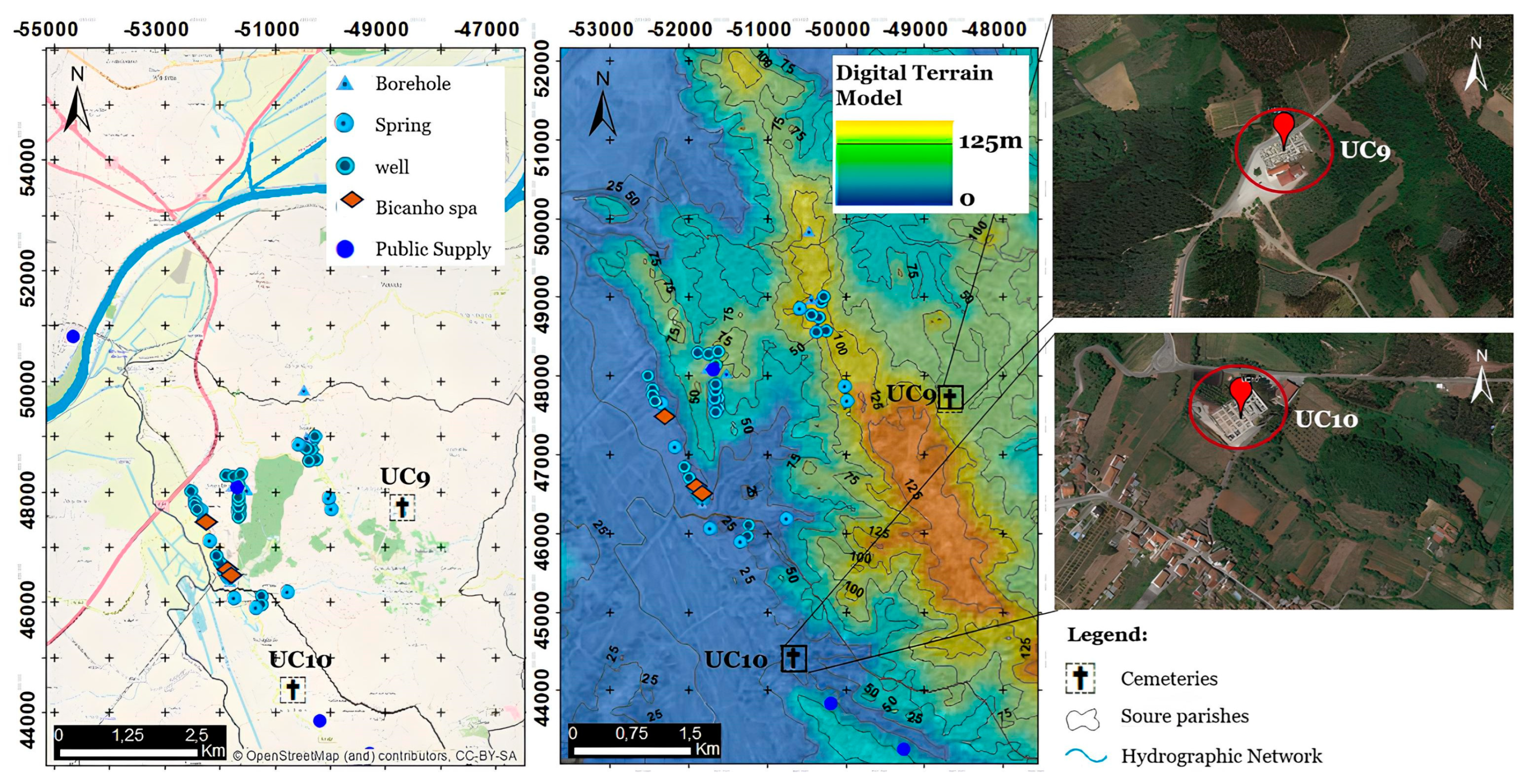
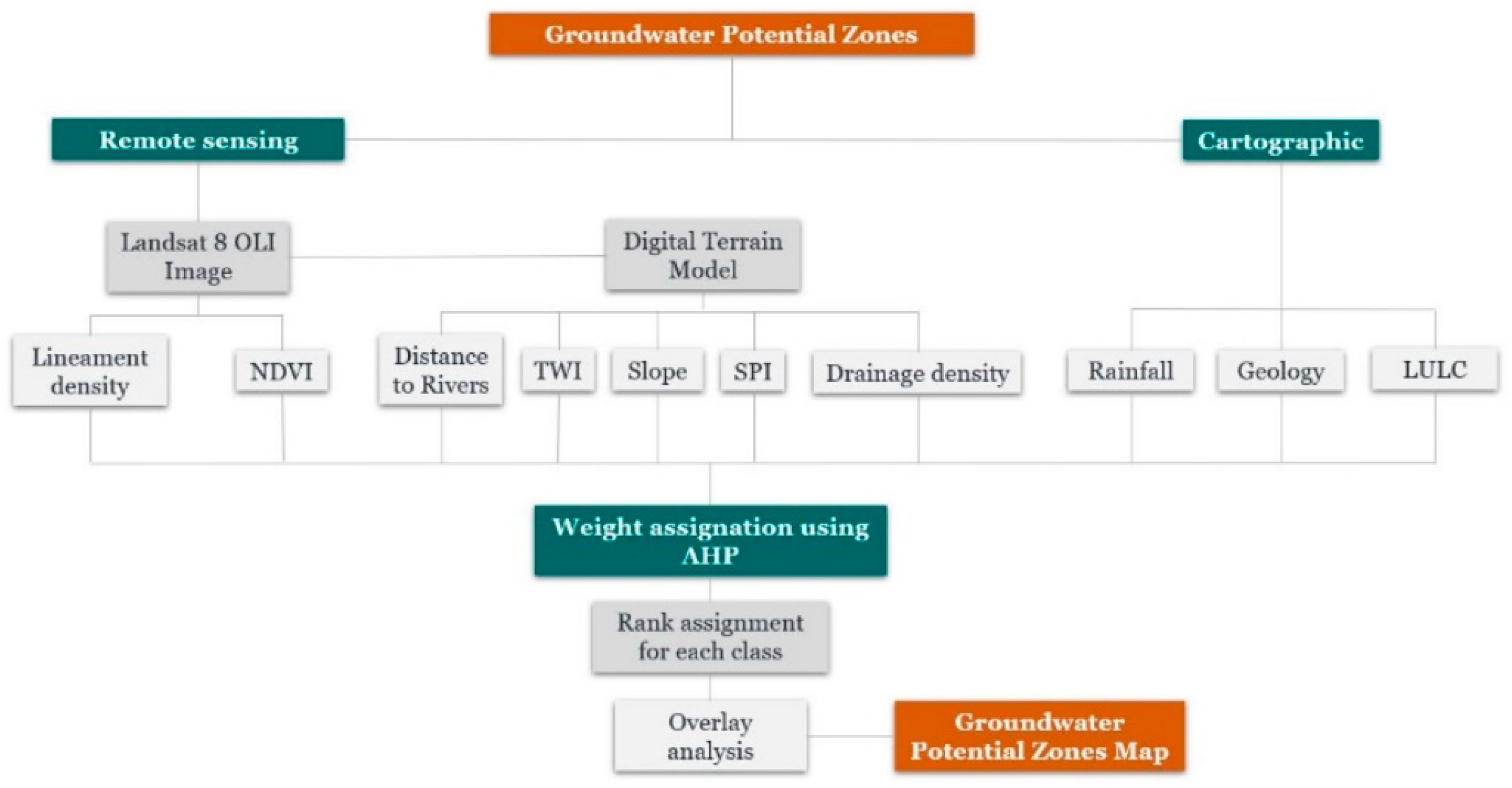
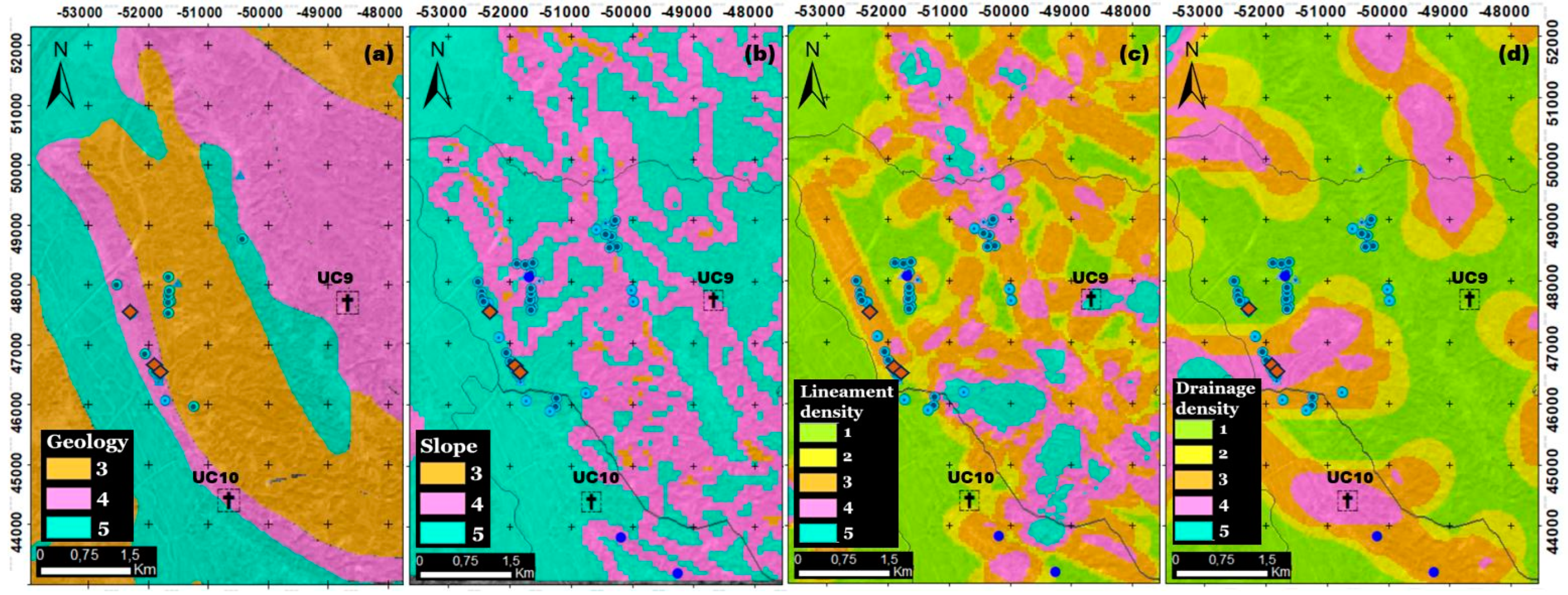
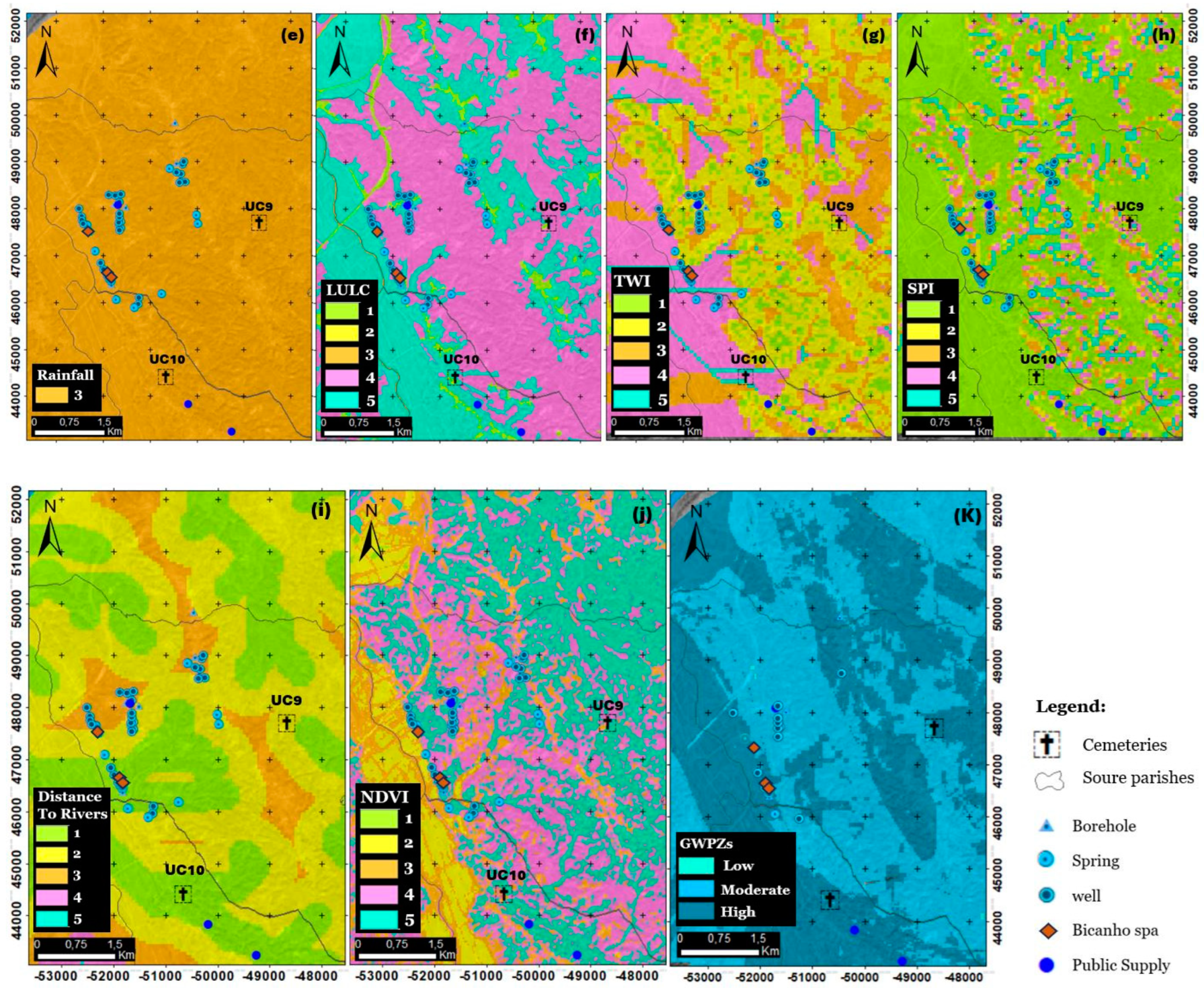
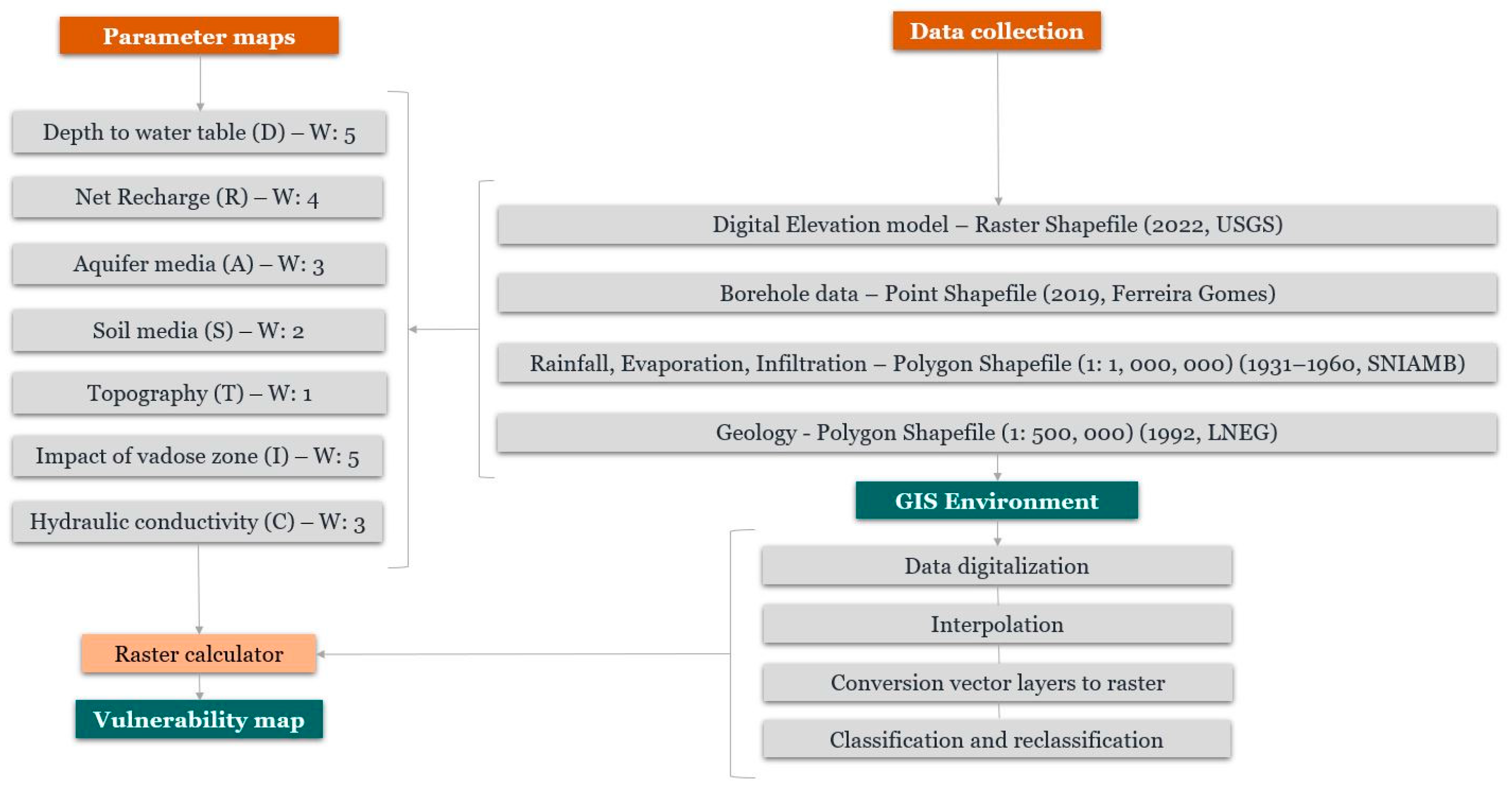
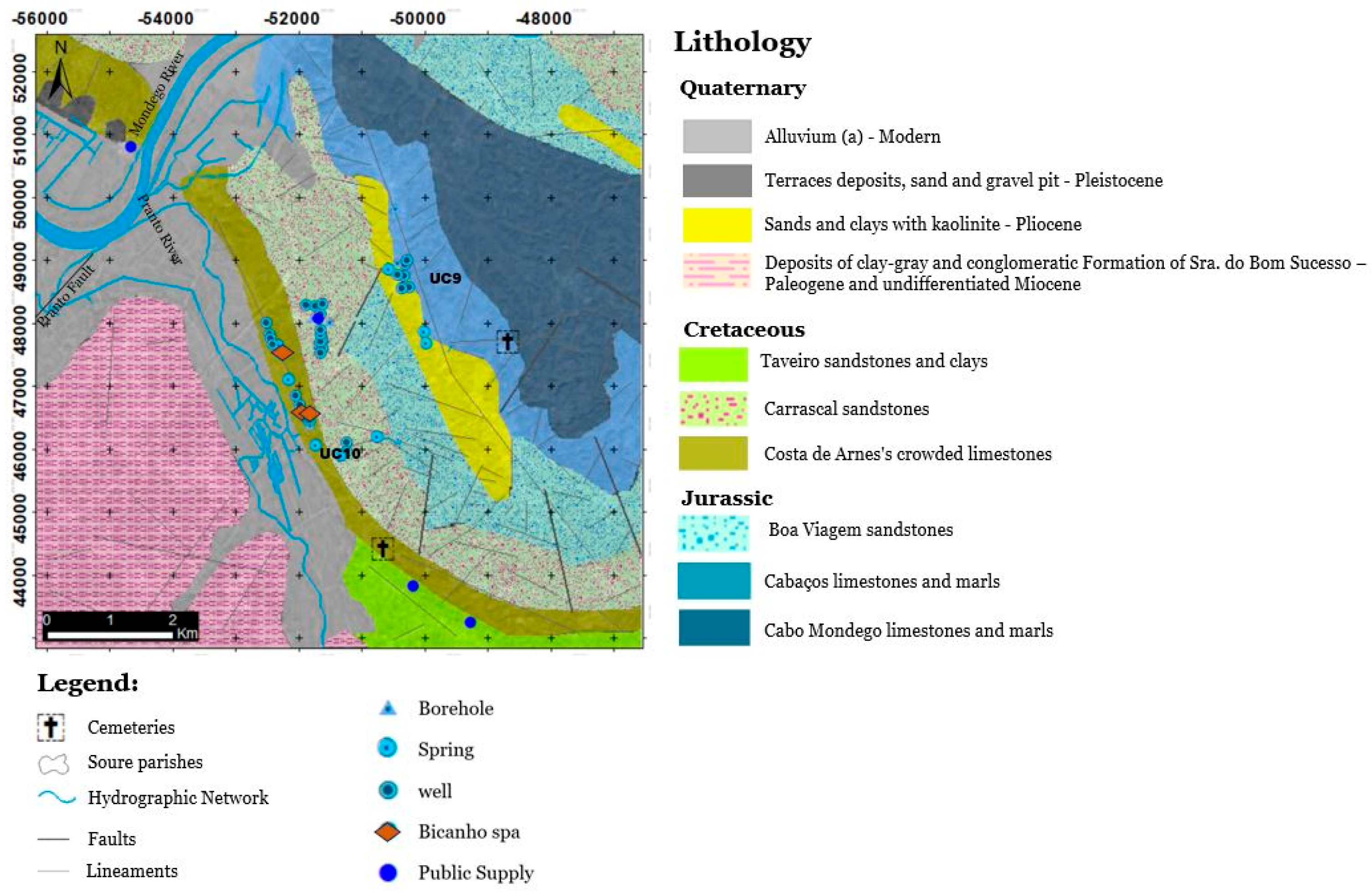
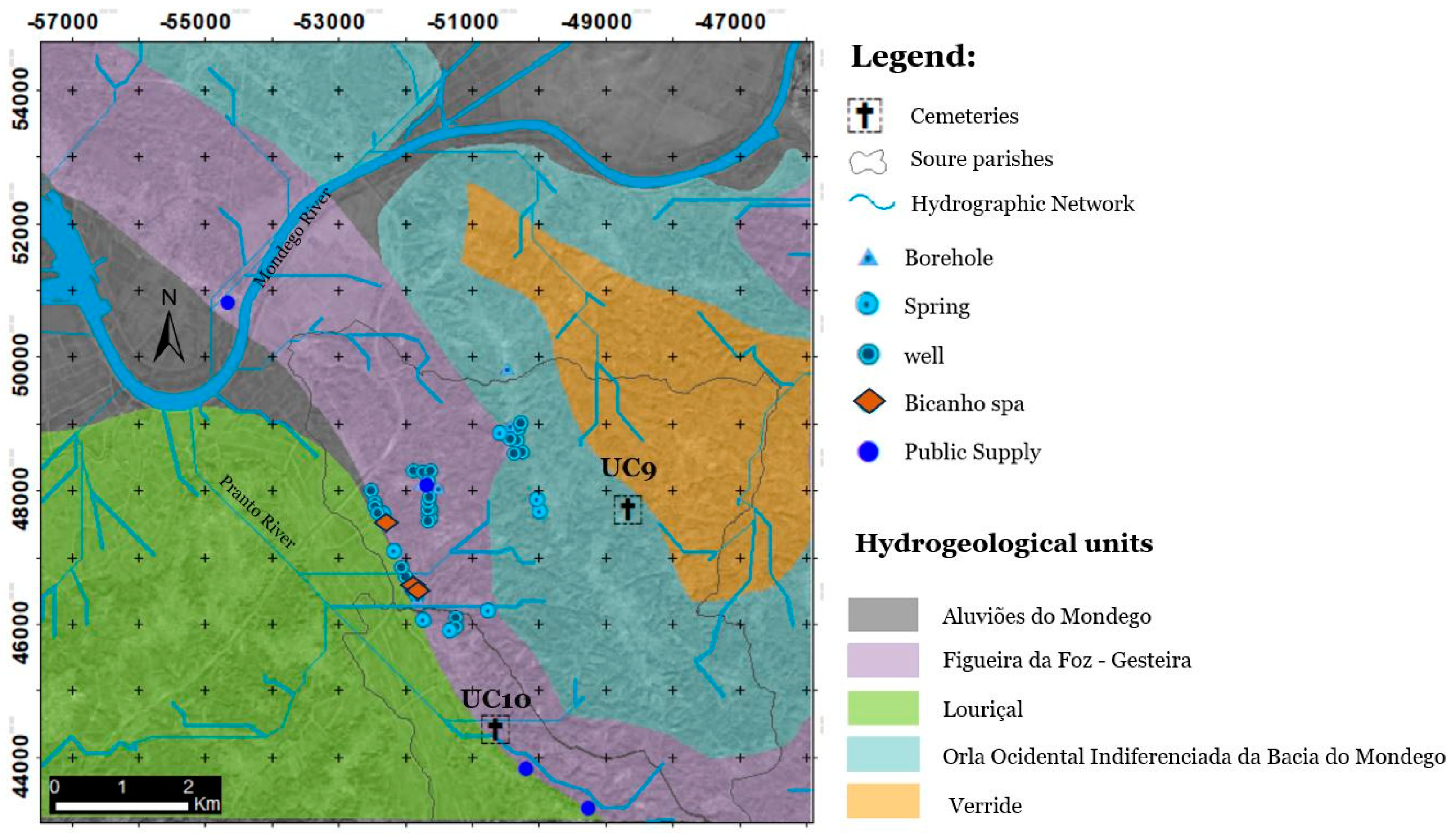
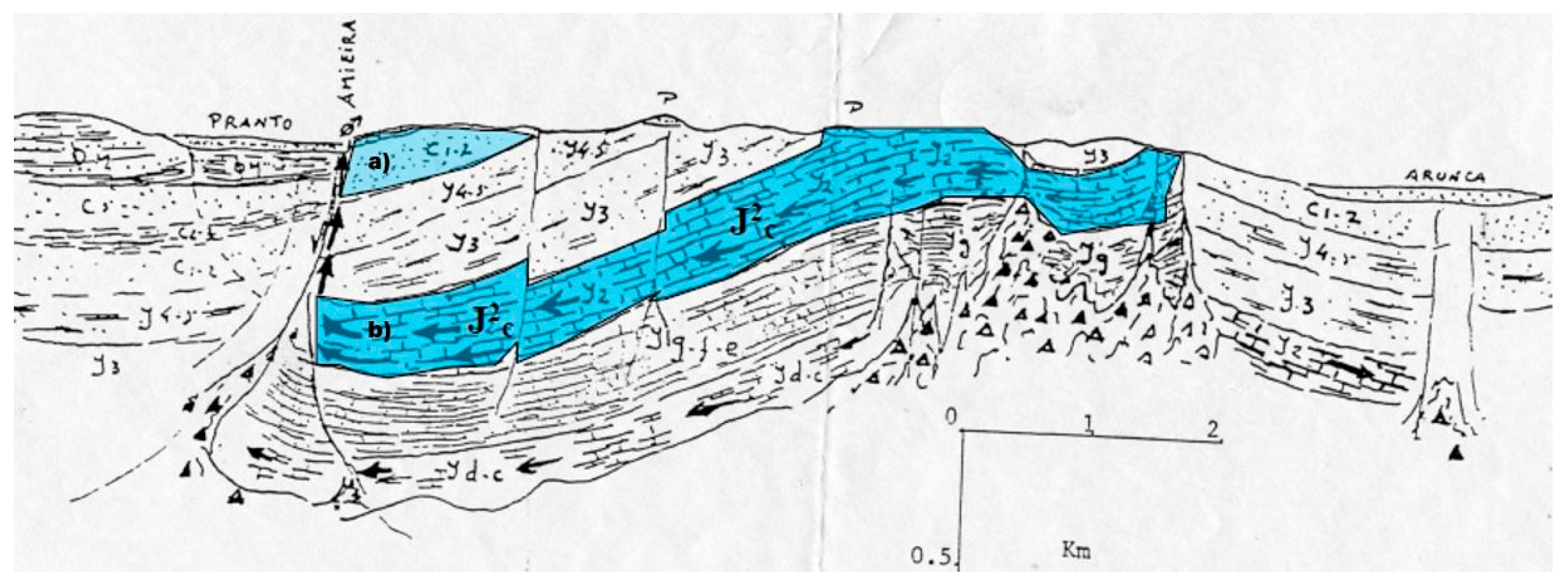

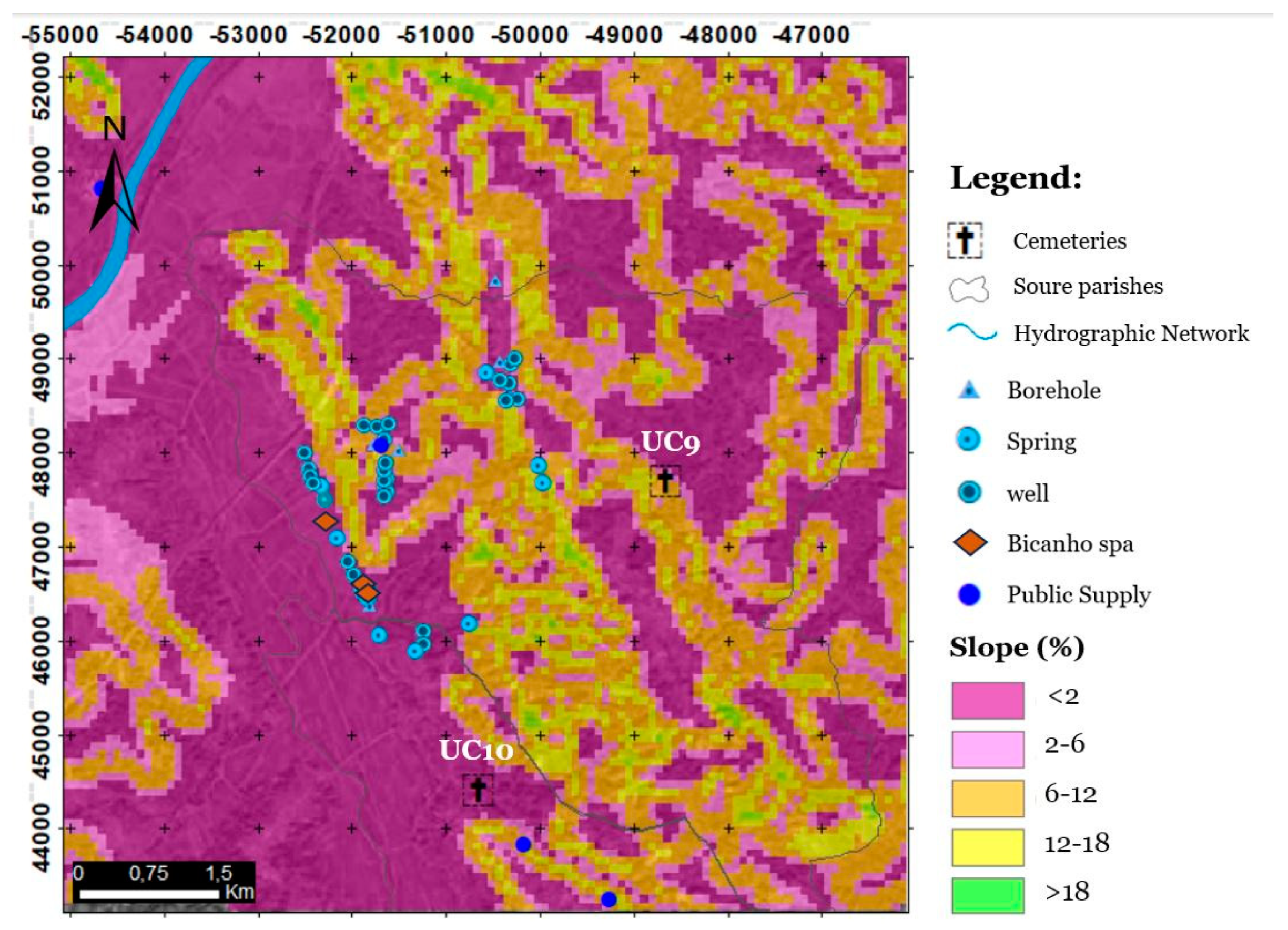

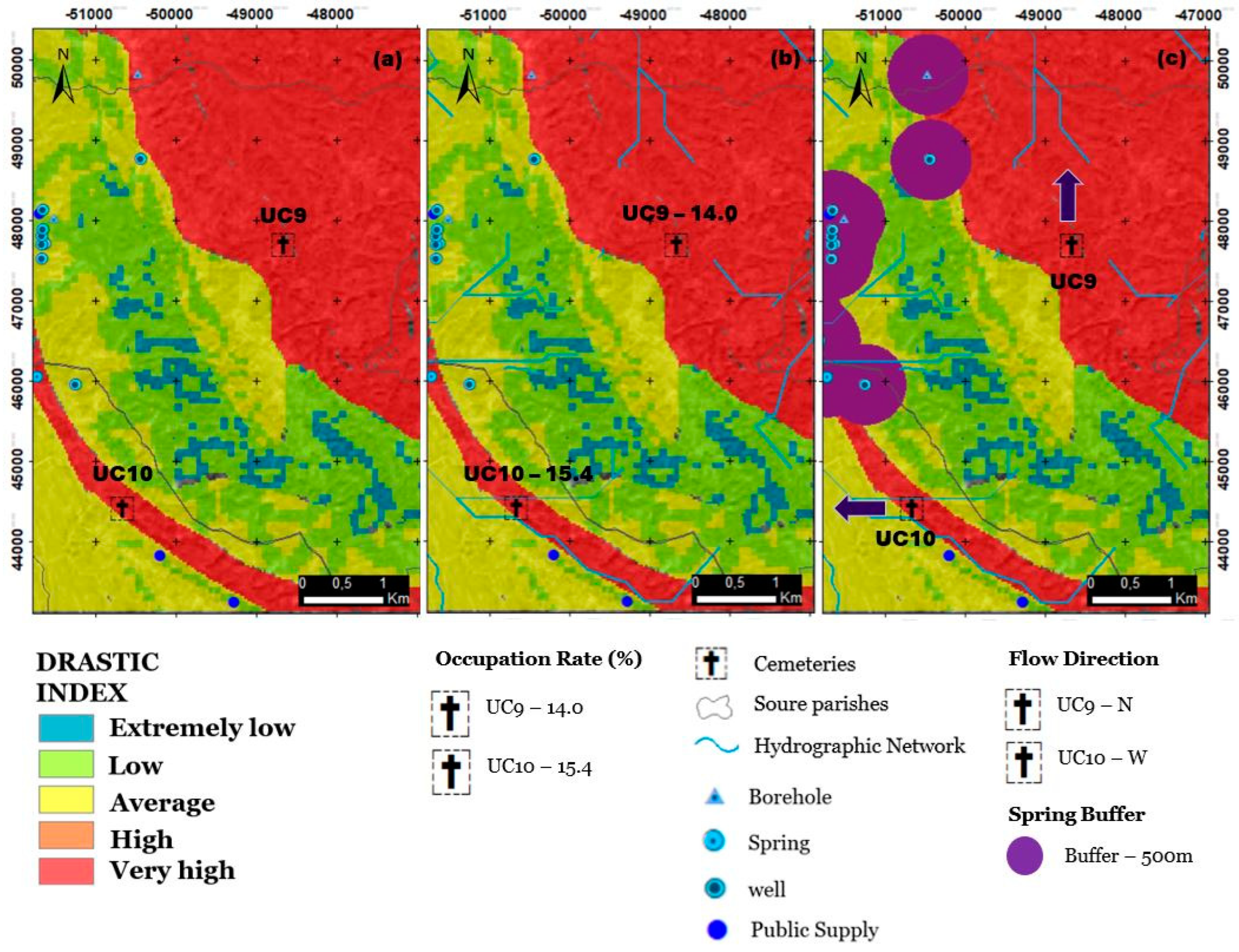

| Data Type | Source | Format | Cell Size | Date | Used to Produce |
|---|---|---|---|---|---|
| DEM | USGS | Raster | 30 × 30 m | 2022 | Lineament density, NDVI, DTM—Distance to Rivers, TWI, Slope, SPI, Drainage density |
| Rainfall | SNIAMB | Shapefile polygon (1:1,000,000) converted to raster | 1931–1960 | Annual precipitation—Recharge | |
| Geology | LNEG | Shapefile polygon (1:500,000) converted to raster | 1992 | Geology | |
| LULC | DGT | Shapefile polygon (1:25,000) converted to raster | 2018 | LULC |
| Variable | Units | NLW | % | Classes | Class Rank | NCR |
|---|---|---|---|---|---|---|
| Geology | - | 0.296 | 29.6 | Alluvium | 5 | 0.17 |
| Sands and clays with kaolinite | 5 | 0.14 | ||||
| Taveiro sandstones and clays | 3 | 0.10 | ||||
| Carrascal sandstones | 3 | 0.14 | ||||
| Costa de Arnes’ crowded limestones | 4 | 0.14 | ||||
| Boa Viagem sandstones | 3 | 0.10 | ||||
| Cabaços limestones and marls | 4 | 0.10 | ||||
| Cabo Mondego limestones and marls | 4 | 0.10 | ||||
| Slope | degree | 0.218 | 21.8 | 0–2 | 5 | 0.33 |
| 2–8 | 4 | 0.27 | ||||
| 8–15 | 3 | 0.20 | ||||
| 15–30 | 2 | 0.13 | ||||
| >30 | 1 | 0.07 | ||||
| Lineament density | Km/Km2 | 0.131 | 13.1 | 0–0.49 | 1 | 0.07 |
| 0.49–1.34 | 2 | 0.13 | ||||
| 1.34–2.18 | 3 | 0.20 | ||||
| 2.18–3.23 | 4 | 0.27 | ||||
| >3.23 | 5 | 0.33 | ||||
| Drainage density (Dd) | Km/Km2 | 0.108 | 10.8 | 0–0.31 | 1 | 0.07 |
| 0.31–0.88 | 2 | 0.13 | ||||
| 0.88–1.53 | 3 | 0.20 | ||||
| 1.53–2.40 | 4 | 0.27 | ||||
| >2.40 | 5 | 0.33 | ||||
| Rainfall | mm/year | 0.090 | 9.0 | 0–298 | 1 | 0.07 |
| 298–740 | 2 | 0.13 | ||||
| 740–1100 | 3 | 0.20 | ||||
| 1100–2070 | 4 | 0.27 | ||||
| >2070 | 5 | 0.33 | ||||
| Land-use/Land-cover (LULC) | - | 0.046 | 4.6 | Urban Area | 1 | 0.07 |
| Bare Ground | 2 | 0.13 | ||||
| Water | 3 | 0.20 | ||||
| Vegetation | 4 | 0.27 | ||||
| Agricultural | 5 | 0.33 | ||||
| Topographic Wetness Index (TWI) | (%) | 0.028 | 2.8 | 0–5.95 | 1 | 0.07 |
| 5.95–8.89 | 2 | 0.13 | ||||
| 8.89–11.84 | 3 | 0.20 | ||||
| 11.84–14.76 | 4 | 0.27 | ||||
| >14.76 | 5 | 0.33 | ||||
| Stream Power Index (SPI) | (%) | 0.028 | 2.8 | 0–5.68 | 1 | 0.07 |
| 5.68–11.36 | 2 | 0.13 | ||||
| 11.38–21.33 | 3 | 0.20 | ||||
| 21.33–57.11 | 4 | 0.27 | ||||
| >57.11 | 5 | 0.33 | ||||
| Distance to Rivers | (m) | 0.031 | 3.1 | 0–138.45 | 5 | 0.33 |
| 138.45–332.27 | 4 | 0.27 | ||||
| 332.27–567.63 | 3 | 0.20 | ||||
| 567.63–858.37 | 2 | 0.13 | ||||
| <858.37 | 1 | 0.07 | ||||
| NDVI | - | 0.024 | 2.4 | −1–0.02 | 1 | 0.07 |
| −0.02–0.09 | 2 | 0.13 | ||||
| 0.09–0.22 | 3 | 0.20 | ||||
| 0.22–0.31 | 4 | 0.27 | ||||
| >0.31 | 5 | 0.33 |
| Seven-Variable Pairwise Comparison Matrix for the AHP Method | ||||||||||
|---|---|---|---|---|---|---|---|---|---|---|
| Variable | Geology | Slope | Lineament Density | Dd | Rainfall | LULC | TWI | SPI | Distance to Rivers | NDVI |
| Geology | 1 | 2 | 3 | 4 | 7 | 8 | 8 | 8 | 7 | 7 |
| Slope | 0.500 | 1 | 3 | 2 | 5 | 5 | 8 | 8 | 7 | 7 |
| Lineament Density | 0.333 | 0.333 | 1 | 2 | 5 | 3 | 4 | 4 | 4 | 5 |
| Drainage Density | 0.250 | 0.500 | 0.500 | 1 | 3 | 3 | 4 | 4 | 4 | 5 |
| Rainfall | 0.143 | 0.200 | 0.200 | 0.333 | 1 | 4 | 5 | 5 | 3 | 7 |
| LULC | 0.125 | 0.200 | 0.333 | 0.333 | 0.250 | 1 | 3 | 3 | 2 | 1 |
| TWI | 0.125 | 0.125 | 0.250 | 0.250 | 0.200 | 0.333 | 1 | 1 | 1 | 2 |
| SPI | 0.125 | 0.125 | 0.250 | 0.250 | 0.200 | 0.333 | 1.000 | 1 | 1 | 2 |
| Distance to Rivers | 0.143 | 0.143 | 0.250 | 0.250 | 0.333 | 0.500 | 1.000 | 1.000 | 1 | 3 |
| NDVI | 0.143 | 0.143 | 0.200 | 0.200 | 0.143 | 1.000 | 0.500 | 0.500 | 0.500 | 1 |
| SUM | 2.887 | 4.769 | 8.983 | 10.617 | 22.126 | 26.167 | 35.500 | 35.500 | 30.500 | 40.000 |
| Scale | Definition | Explanation |
|---|---|---|
| 1 | Equal significance | Each of the two activities contributes equally to the goal |
| 3 | moderate significance over the other | One activity is strongly preferred over another by experience and judgment |
| 5 | Essential or strong significance | One activity is favoured over another by experience and judgement |
| 7 | Very strong significance | An activity is highly preferred, and its practical dominance is evidenced |
| 9 | Extreme significance | The strongest possible order of affirmation is present in the evidence supporting one activity over another |
| 2, 4, 6, 8 | Values in the middle of the two close decisions | When a compromise is required |
| Normalised Pairwise Comparison Matrix | ||||||||||||
|---|---|---|---|---|---|---|---|---|---|---|---|---|
| Variable | Geology | Slope | Lineament Density | Dd | Rainfall | LULC | TWI | SPI | Distance to Rivers | NDVI | Total | NWT |
| Geology | 0.347 | 0.419 | 0.334 | 0.377 | 0.317 | 0.306 | 0.225 | 0.225 | 0.229 | 0.179 | 2.958 | 0.296 |
| Slope | 0.173 | 0.210 | 0.334 | 0.189 | 0.226 | 0.191 | 0.225 | 0.225 | 0.229 | 0.179 | 2.181 | 0.218 |
| Lineament Density | 0.115 | 0.070 | 0.111 | 0.189 | 0.226 | 0.115 | 0.113 | 0.113 | 0.131 | 0.128 | 1.311 | 0.131 |
| Drainage Density | 0.087 | 0.105 | 0.056 | 0.094 | 0.136 | 0.115 | 0.113 | 0.113 | 0.131 | 0.128 | 1.078 | 0.108 |
| Rainfall | 0.049 | 0.042 | 0.022 | 0.031 | 0.045 | 0.153 | 0.141 | 0.141 | 0.098 | 0.179 | 0.901 | 0.090 |
| LULC | 0.043 | 0.042 | 0.037 | 0.031 | 0.011 | 0.038 | 0.084 | 0.084 | 0.065 | 0.026 | 0.461 | 0.046 |
| TWI | 0.043 | 0.026 | 0.028 | 0.023 | 0.009 | 0.013 | 0.028 | 0.028 | 0.033 | 0.051 | 0.282 | 0.028 |
| SPI | 0.043 | 0.026 | 0.028 | 0.023 | 0.009 | 0.013 | 0.028 | 0.028 | 0.033 | 0.051 | 0.282 | 0.028 |
| Distance to Rivers | 0.049 | 0.030 | 0.028 | 0.023 | 0.015 | 0.019 | 0.028 | 0.028 | 0.033 | 0.051 | 0.304 | 0.031 |
| NDVI | 0.049 | 0.030 | 0.022 | 0.019 | 0.006 | 0.038 | 0.014 | 0.014 | 0.016 | 0.026 | 0.234 | 0.024 |
| N | 1 | 2 | 3 | 4 | 5 | 6 | 7 | 8 | 9 | 10 | 11 | 12 | 13 | 14 | 15 |
| RI | 0.00 | 0.00 | 0.58 | 0.90 | 1.12 | 1.24 | 1.32 | 1.41 | 1.45 | 1.51 | 1.52 | 1.54 | 1.56 | 1.58 | 1.59 |
| Cemetery | Geology | Slope | Line Density | Dd | Rainfall | LULC | TWI | SPI | Distance to Rivers | NDVI | GWPZ |
|---|---|---|---|---|---|---|---|---|---|---|---|
| UC9 | 4 | 4 | 5 | 1 | 3 | 4 | 2 | 4 | 2 | 5 | Moderate |
| UC10 | 4 | 5 | 1 | 4 | 3 | 5 | 4 | 1 | 1 | 3 | Good |
| Parameter | Partial Indices (PIs) Function of the Various Parameters and Their Classes | ||||||||||||
|---|---|---|---|---|---|---|---|---|---|---|---|---|---|
| D | Depth (m) | <1.50 | 1.50–4.60 | 4.60–9.10 | 9.10–15.20 | 15.20–22.90 | 22.90–30.50 | >30.50 | |||||
| Ip | 10 | 9 | 7 | 5 | 3 | 2 | 1 | ||||||
| R | Recharge (mm/year) | <51 | 51–102 | 102–178 | 178–254 | >254 | |||||||
| Ip | 1 | 3 | 6 | 8 | 9 | ||||||||
| A | Aquifer material | clayey schist, clay-stone | metamorphic/ igneous rock | metamorphic/ igneous-altered rock | glacial deposits | sandstone, limestone, and claystone, stratified | sandstone | limestone | sand and gravel | basalt | carsified limestone | ||
| Ip | 1–3 | 2–5 | 3–5 | 4–6 | 5–9 | 4–9 | 4–9 | 4–9 | 2–10 | 9–10 | |||
| Ip Typical | 2 | 3 | 4 | 5 | 6 | 6 | 6 | 8 | 9 | 10 | |||
| S | Soil Type | thin or absent | gravel | sand | peat | consistent clay and/or expansible | sandy | loam | silty | clayey | muddy | non-expan. Clay | |
| Ip | 10 | 10 | 9 | 8 | 7 | 6 | 5 | 4 | 3 | 2 | 1 | ||
| T | Slope (%) | <2 | 2–6 | 6–12 | 12–18 | >18 | |||||||
| Ip | 10 | 9 | 5 | 3 | 1 | ||||||||
| I | Unsaturated zone | confining layer | clay/ silt | clayey schist, claystone | limestone | sandstone | sandstone, limestone, and claystone, stratified | sand and gravel with many fines | metamorphic/ igneous rock | sand and gravel | basalt | carsified limestone | |
| Ip | 1 | 2–6 | 2–5 | 2–7 | 4–8 | 4–8 | 4–8 | 2–8 | 6–9 | 2–10 | 8–10 | ||
| Ip Typical | 1 | 3 | 3 | 6 | 6 | 6 | 6 | 4 | 8 | 9 | 10 | ||
| C | K (m/day) | <4.1 | 4.1–12.2 | 12.2–28.5 | 28.5–40.7 | 40.7–81.5 | >81.5 | ||||||
| Ip | 1 | 2 | 4 | 6 | 8 | 10 | |||||||
| DRASTIC Index | |
|---|---|
| Quantitative Classes | Qualitative Vulnerability |
| 23–79 | Insignificant |
| 80–99 | Extremely low |
| 100–119 | Very low |
| 120–139 | Low |
| 140–159 | Average |
| 160–179 | High |
| 180–199 | Very high |
| 200–226 | Extremely high |
| Normal DRASTIC Index [40] | Potential Vulnerability (%) | Degree | Qualitative Vulnerability |
|---|---|---|---|
| <80 | <30 | 1 | Nonexistent |
| 80–99 | 30–39 | 2 | Very very low |
| 100–119 | 40–49 | 3 | Very low |
| 120–139 | 50–59 | 4 | Low |
| 140–159 | 60–69 | 5 | Moderate |
| 160–179 | 70–79 | 6 | High |
| 180–199 | 80–89 | 7 | Very high |
| >199 | >90 | 8 | Extremely high |
| Unit | Parameter | Class | Index | Weight | Partial Index | DRASTIC | Vulnerability |
|---|---|---|---|---|---|---|---|
| I—Recent alluvium (free aquifer) | D | <1.5 m | 10 | 5 | 50 | 148 | Pollution is usually moderate but can occasionally be very high; it spreads quickly in flooded areas and along gravel lenticles. |
| R | 102–178 mm/year | 6 | 4 | 24 | |||
| A | Sand and gravel with many fines | 8 | 3 | 24 | |||
| S | Muddy | 2 | 2 | 4 | |||
| T | <2% | 10 | 1 | 10 | |||
| I | Sand and gravel with many fines | 6 | 5 | 30 | |||
| C | 4.1–12.2 m/day | 2 | 3 | 6 | |||
| II—Taveiro sands and clays (Upper Cretaceous, free aquifer) | D | 1.5–4.6 m | 9 | 5 | 45 | 136 | In general, low, because clay minerals allow heavy-metal adsorption. |
| R | 102–178 mm/year | 6 | 4 | 24 | |||
| A | Sand and gravel with clay | 7 | 3 | 21 | |||
| S | Clay loam | 3 | 2 | 6 | |||
| T | 2–6% | 9 | 1 | 9 | |||
| I | Sand and gravel with clay | 5 | 5 | 25 | |||
| C | 4.1–12.2 m/day | 2 | 3 | 6 | |||
| III—Costa de Arnes crowded limestones (Upper Cretaceous, free aquifer) | D | 1.5–4.6 m | 9 | 5 | 45 | 197 | The presence of karst limestones makes the lithological unit that contains UC10 very vulnerable. |
| R | 178–254 mm/year | 8 | 4 | 32 | |||
| A | Karsified limestone | 10 | 3 | 30 | |||
| S | Clay loam | 3 | 2 | 6 | |||
| T | <2% | 10 | 1 | 10 | |||
| I | Karsified limestone | 10 | 5 | 50 | |||
| C | 40.7–81.5 m/day | 8 | 3 | 24 | |||
| IV—Carrascal Sandstones (Middle Cretaceous, free to confined/semi-confined aquifer) | D | 1.5–4.6 m | 9 | 5 | 45 | 159 | In general, average |
| R | 178–254 mm/year | 8 | 4 | 32 | |||
| A | Sand and gravel | 8 | 3 | 24 | |||
| S | Silty loam | 4 | 2 | 16 | |||
| T | 2–6% | 9 | 1 | 9 | |||
| I | Sand and gravel with many fines | 6 | 5 | 30 | |||
| C | <4.1 m/day | 1 | 3 | 3 | |||
| V—Sands and clays with kaolinite (Pliocene, free aquifer) | D | 1.5–4.6 m | 9 | 5 | 45 | 136 | In general, low, because clay minerals allow heavy-metal adsorption. |
| R | 102–178 mm/year | 6 | 4 | 24 | |||
| A | Sand and gravel with kaolinite | 7 | 3 | 21 | |||
| S | Clay loam | 3 | 2 | 6 | |||
| T | 2–6% | 9 | 1 | 9 | |||
| I | Sand and gravel with kaolinite | 5 | 5 | 25 | |||
| C | 4.1–12.2 m/day | 2 | 3 | 6 | |||
| VI—Cabaços Limestones and Marls (Upper Jurassic, free to confined/semi-confined aquifer) | D | 1.5–4.6 m | 9 | 5 | 45 | 192 | The presence of karst limestones makes the lithological unit that contains UC9 very vulnerable. |
| R | 178–254 mm/year | 8 | 4 | 32 | |||
| A | Karsified limestone | 10 | 3 | 30 | |||
| S | Clay loam | 3 | 2 | 6 | |||
| T | 6–12% | 5 | 1 | 5 | |||
| I | Karsified limestone | 10 | 5 | 50 | |||
| C | 40.7–81.5 m/day | 8 | 3 | 24 | |||
| VII—Cabo Mondego Limestones and Marls (Middle Jurassic, free to confined/semi-confined aquifer) | D | 1.5–4.6 m | 9 | 5 | 45 | 189 | The presence of karst limestones makes the lithological unit very vulnerable. |
| R | 102–178 mm/year | 6 | 4 | 24 | |||
| A | Karsified limestone | 10 | 3 | 30 | |||
| S | Clay loam | 3 | 2 | 6 | |||
| T | <2% | 10 | 1 | 10 | |||
| I | Karsified limestone | 10 | 5 | 50 | |||
| C | 40.7–81.5 m/day | 8 | 3 | 24 | |||
| VIII—Boa Viagem Sandstones (Upper Jurassic, free to confined/semi-confined aquifer) | D | 4.6–9.1 | 7 | 5 | 35 | 131 | In general, low |
| R | 102–178 mm/year | 6 | 4 | 24 | |||
| A | Sandstone, limestone, and claystone, stratified | 6 | 3 | 18 | |||
| S | Clay loam | 3 | 2 | 12 | |||
| T | 2–6% | 9 | 1 | 9 | |||
| I | Sandstone, limestone, and claystone, stratified | 6 | 5 | 30 | |||
| C | <4.1 m/day | 1 | 3 | 3 |
| Unit | DRASTIC Index | Potential Vulnerability (%) | Degree | Qualitative Vulnerability | Specific Vulnerability Degree | Qualitative Vulnerability |
|---|---|---|---|---|---|---|
| I—Recent alluvium (free aquifer) | 148 | 60–69 | 5 | Moderate | 4 | Low |
| II—Taveiro sands and clays (Upper Cretaceous, free aquifer) | 136 | 50–59 | 4 | Low | 4 | Low |
| III—Costa de Arnes crowded limestones (Upper Cretaceous, free aquifer) | 197 | 80–89 | 7 | Very high | 7 | Very high |
| IV—Carrascal Sandstones (Middle Cretaceous, free to confined/semi-confined aquifer) | 159 | 60–69 | 5 | Moderate | 5 | Moderate |
| V—Sands and clays with kaolinite (Pliocene, free aquifer) | 136 | 50–59 | 4 | Low | 3 | Very Low |
| VI—Cabaços Limestones and Marls (Upper Jurassic, free to confined/semi-confined aquifer) | 192 | 80–89 | 7 | Very high | 7 | Very high |
| VII—Cabo Mondego Limestones and Marls (Middle Jurassic, free to confined/semi-confined aquifer) | 189 | 80–89 | 7 | Very high | 6 | High |
| VIII—Boa Viagem Sandstones (Upper Jurassic, free to confined/semi-confined aquifer) | 131 | 50–59 | 4 | Low | 3 | Very Low |
Disclaimer/Publisher’s Note: The statements, opinions and data contained in all publications are solely those of the individual author(s) and contributor(s) and not of MDPI and/or the editor(s). MDPI and/or the editor(s) disclaim responsibility for any injury to people or property resulting from any ideas, methods, instructions or products referred to in the content. |
© 2024 by the authors. Licensee MDPI, Basel, Switzerland. This article is an open access article distributed under the terms and conditions of the Creative Commons Attribution (CC BY) license (https://creativecommons.org/licenses/by/4.0/).
Share and Cite
Gonçalves, V.; Albuquerque, A.; Almeida, P.G.; Ferreira Gomes, L.; Cavaleiro, V. Delineation of Potential Groundwater Zones and Assessment of Their Vulnerability to Pollution from Cemeteries Using GIS and AHP Approaches Based on the DRASTIC Index and Specific DRASTIC. Water 2024, 16, 585. https://doi.org/10.3390/w16040585
Gonçalves V, Albuquerque A, Almeida PG, Ferreira Gomes L, Cavaleiro V. Delineation of Potential Groundwater Zones and Assessment of Their Vulnerability to Pollution from Cemeteries Using GIS and AHP Approaches Based on the DRASTIC Index and Specific DRASTIC. Water. 2024; 16(4):585. https://doi.org/10.3390/w16040585
Chicago/Turabian StyleGonçalves, Vanessa, Antonio Albuquerque, Pedro Gabriel Almeida, Luís Ferreira Gomes, and Victor Cavaleiro. 2024. "Delineation of Potential Groundwater Zones and Assessment of Their Vulnerability to Pollution from Cemeteries Using GIS and AHP Approaches Based on the DRASTIC Index and Specific DRASTIC" Water 16, no. 4: 585. https://doi.org/10.3390/w16040585
APA StyleGonçalves, V., Albuquerque, A., Almeida, P. G., Ferreira Gomes, L., & Cavaleiro, V. (2024). Delineation of Potential Groundwater Zones and Assessment of Their Vulnerability to Pollution from Cemeteries Using GIS and AHP Approaches Based on the DRASTIC Index and Specific DRASTIC. Water, 16(4), 585. https://doi.org/10.3390/w16040585








